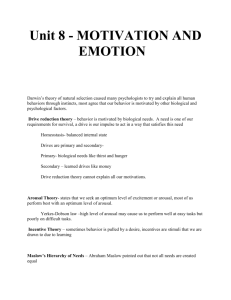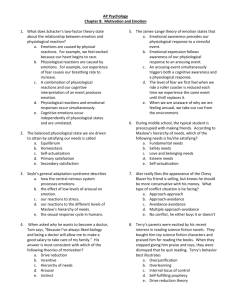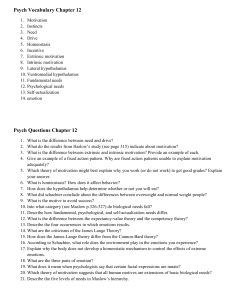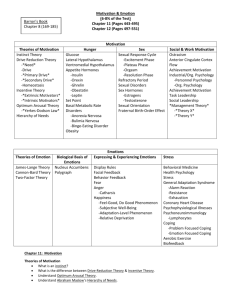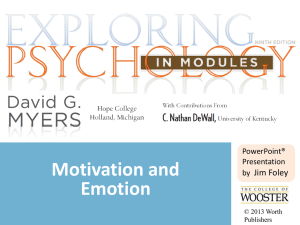Lecture8
advertisement
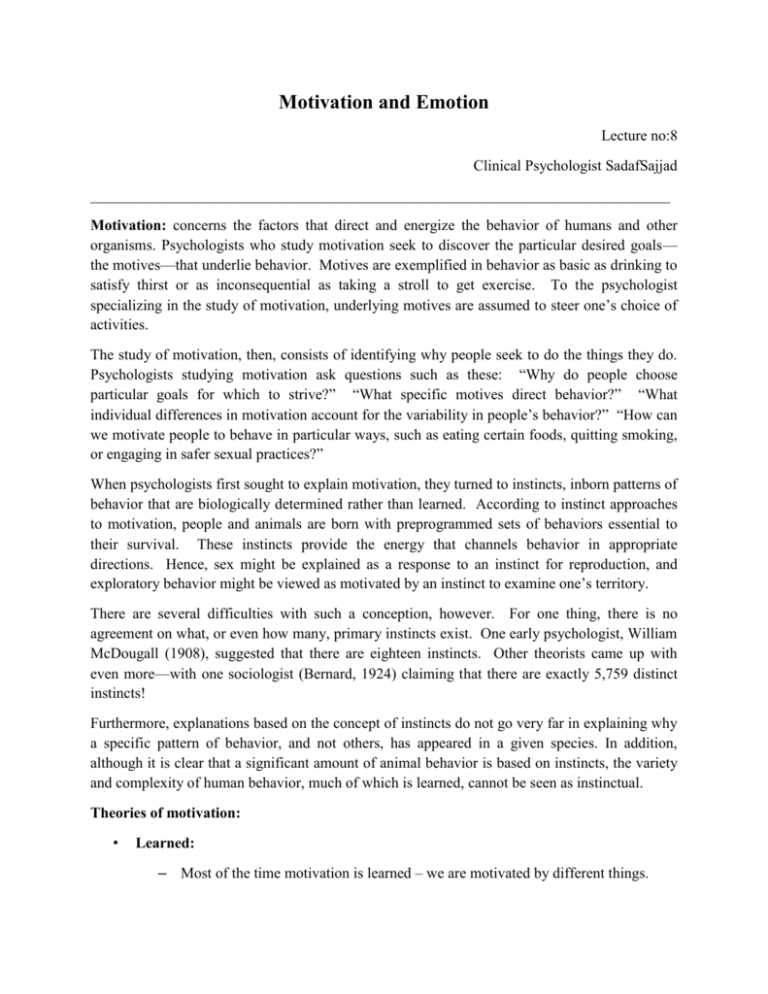
Motivation and Emotion Lecture no:8 Clinical Psychologist SadafSajjad _____________________________________________________________________________ Motivation: concerns the factors that direct and energize the behavior of humans and other organisms. Psychologists who study motivation seek to discover the particular desired goals— the motives—that underlie behavior. Motives are exemplified in behavior as basic as drinking to satisfy thirst or as inconsequential as taking a stroll to get exercise. To the psychologist specializing in the study of motivation, underlying motives are assumed to steer one’s choice of activities. The study of motivation, then, consists of identifying why people seek to do the things they do. Psychologists studying motivation ask questions such as these: “Why do people choose particular goals for which to strive?” “What specific motives direct behavior?” “What individual differences in motivation account for the variability in people’s behavior?” “How can we motivate people to behave in particular ways, such as eating certain foods, quitting smoking, or engaging in safer sexual practices?” When psychologists first sought to explain motivation, they turned to instincts, inborn patterns of behavior that are biologically determined rather than learned. According to instinct approaches to motivation, people and animals are born with preprogrammed sets of behaviors essential to their survival. These instincts provide the energy that channels behavior in appropriate directions. Hence, sex might be explained as a response to an instinct for reproduction, and exploratory behavior might be viewed as motivated by an instinct to examine one’s territory. There are several difficulties with such a conception, however. For one thing, there is no agreement on what, or even how many, primary instincts exist. One early psychologist, William McDougall (1908), suggested that there are eighteen instincts. Other theorists came up with even more—with one sociologist (Bernard, 1924) claiming that there are exactly 5,759 distinct instincts! Furthermore, explanations based on the concept of instincts do not go very far in explaining why a specific pattern of behavior, and not others, has appeared in a given species. In addition, although it is clear that a significant amount of animal behavior is based on instincts, the variety and complexity of human behavior, much of which is learned, cannot be seen as instinctual. Theories of motivation: • Learned: – Most of the time motivation is learned – we are motivated by different things. • Instinct theory: – Inborn patterns of behavior that is biologically determined rather than learned. – According to instinct approaches to motivation, people and animals are born with preprogrammed sets of behaviors essential to their survival. These instincts provide the energy that channels behavior in appropriate directions. Example: exploratory behavior in animals: The tendency to explore or investigate an environment. Drive Deduction Theory: Our behavior is motivated by BIOLOGICAL NEEDS. After rejecting instinct theory, psychologists first proposed simple drive-reduction theories of motivation in its place (Hull, 1943). Drive theories assume that people are always trying to reduce internal tension. Therefore, drive theories believe that the source of motivation lies within the person (not from the environment) Example: when people lack some basic biological requirement such as water, a drive to obtain that requirement (in this case, the thirst drive) is produced. To understand this approach, we need to begin with the concept of drive. A drive is motivational tension, or arousal, that energizes behavior in order to fulfill some need. Many basic kinds of drives, such as hunger, thirst, sleepiness, and sex, are related to biological needs of the body or of the species as a whole. These are called primary drives. Primary drives contrast with secondary drives, in which no obvious biological need is being fulfilled. In secondary drives, needs are brought about by prior experience and learning. As we will discuss later, some people have strong needs to achieve academically and in their careers. We can say that their achievement need is reflected in a secondary drive that motivates their behavior. We usually try to satisfy a primary drive by reducing the need underlying it. For example, we become hungry after not eating for a few hours and may raid the refrigerator, especially if our next scheduled meal is not imminent. If the weather turns cold, we put on extra clothing or raise the setting on the thermostat in order to keep warm. If our body needs liquids in order to function properly, we experience thirst and seek out water. The reason for such behavior is homeostasis, a basic motivational phenomenon underlying primary drives. Homeostasis is the body’s tendency to maintain a steady internal state. Homeostasis operates through feedback loops that bring deviations in body functioning back to a more optimal state, similar to the way a thermostat and furnace work in a home heating system to maintain a steady temperature (see Figure 10-1). Receptor cells throughout the body constantly monitor factors such as temperature and nutrient levels, and when deviations from the ideal state occur, the body adjusts in an effort to return to an optimal state. Many of our fundamental needs, including the need for food, water, stable body temperature, and sleep, operate via homeostasis. Arousal Theory: Arousal approaches seek to explain behavior in which the goal is to maintain or increase excitement (Berlyne, 1967; Brehm & Self, 1989). According to arousal approaches to motivation, each of us tries to maintain a certain level of stimulation and activity. As with the drive-reduction model, if our stimulation and activity levels become too high, we try to reduce them. But in contrast to the drive-reduction model, the arousal model also suggests that if the levels of stimulation and activity are too low, we will try to increase them by seeking stimulation. People vary widely in the optimal level of arousal that they seek out, with some people seeking out especially high levels of arousal. For example, psychologists have hypothesized that individuals such as comic John Belushi, daredevil Evel Knievel, and bank robbers Bonnie and Clyde exhibited a particularly high need for arousal. You can get a sense of your own preferred level of stimulation by completing the questionnaire in Table 10-1 (Zuckerman, 1991, 1994; Farley, 1986). Incentive Approaches: Motivation’s Pull: It suggests that motivation stems from the desire to obtain valued external goals, or incentives. In this view, the desirable properties of external stimuli—be they grades, money, affection, food, or sex—account for a person’s motivation. Although the theory explains why we may succumb to an incentive (like a mouth-watering dessert) even though internal cues (like hunger) are lacking, it does not provide a complete explanation of motivation, since organisms seek to fulfill needs even when incentives are not apparent. Consequently, many psychologists believe that the internal drives proposed by drivereduction theory work in tandem with the external incentives of incentive theory to “push” and “pull” behavior, respectively. Thus, at the same time we seek to satisfy our underlying hunger needs (the push of drive-reduction theory), we are drawn to food that appears particularly appetizing (the pull of incentive theory). Rather than contradicting each other, then, drives and incentives may work together in motivating behavior (Petri, 1996). Cognitive Approaches: The Thoughts behind Motivation: Cognitive approaches to motivation suggest that motivation is a product of people’s thoughts, expectations, and goals—their cognitions. For instance, the degree to which people are motivated to study for a test is based on their expectation of how well studying will pay off in terms of a good grade. Cognitive theories of motivation draw a key distinction between intrinsic and extrinsic motivation. Intrinsic motivation causes us to participate in an activity for our own enjoyment, rather than for any concrete, tangible reward that it will bring us. In contrast, extrinsic motivation causes us to do something for money, a grade, or some other concrete, tangible reward. For example, when a physician works long hours because she loves medicine, intrinsic motivation is prompting her; if she works hard in order to make a lot of money, extrinsic motivation underlies her efforts. We are more apt to persevere, work harder, and produce work of higher quality when motivation for a task is intrinsic rather than extrinsic. In fact, providing rewards for desirable behavior actually may cause intrinsic motivation to decline and extrinsic motivation to increase, although this conclusion is controversial. In a dramatic demonstration of the differing effects of rewards on motivation, researchers promised a group of nursery school students a reward for drawing with magic markers (an activity for which they had previously shown high motivation). The reward served to reduce their enthusiasm for the task, for they later showed considerably less zeal for drawing (Lepper & Greene, 1978). It was as if the promise of reward undermined their intrinsic interest in drawing, turning what had been play into work. Such research suggests the importance of promoting intrinsic motivation and indicates that providing extrinsic rewards (or even just calling attention to them) may actually undermine the effort and quality of performance. The Need for Achievement: Striving for Success: The need for achievement is a stable, learned characteristic in which satisfaction is obtained by striving for and attaining a level of excellence (McClelland et al., 1953). People with a high need for achievement seek out situations in which they can compete against some standard—be it grades, money, or winning at a game—and prove themselves successful. But they are not indiscriminate when it comes to picking their challenges: They tend to avoid situations in which success will come too easily (which would be unchallenging) and situations in which success is unlikely. Instead, people high in achievement motivation are apt to choose tasks that are of intermediate difficulty. In contrast, people with low achievement motivation tend to be motivated primarily by a desire to avoid failure. As a result, they seek out easy tasks, being sure to avoid failure, or they seek out very difficult tasks for which failure has no negative implications, since almost anyone would fail at them. People with a high fear of failure will stay away from tasks of intermediate difficulty, since they may fail where others have been successful How can we measure a person’s need for achievement? The technique used most frequently is to administer a Thematic Apperception Test (TAT) (Spangler, 1992). In the TAT, people are shown a series of ambiguous pictures, such as the one in Figure 10-6. They are told to write a story that describes what is happening, who the people are, what led to the situation, what the people are thinking or wanting, and what will happen next. A standard scoring system is then used to determine the amount of achievement imagery in people’s stories. For example, someone who writes a story in which the main character is striving to beat an opponent, studying in order to do well at some task, or working hard in order to get a promotion shows clear signs of an achievement orientation. It is assumed that the inclusion of such achievement-related imagery in their stories indicates an unusually high degree of concern with—and therefore a relatively strong need for—achievement. most people have a need for affiliation, an interest in establishing and maintaining relationships with other people. Individuals with a high need for affiliation write TAT stories that emphasize the desire to maintain or reinstate friendships and show concern over being rejected by friends. People who are higher in affiliation needs are particularly sensitive to relationships with others. They desire to be with their friends more of the time, and alone less often, than people who are lower in the need for affiliation. The need for power, a tendency to seek impact, control, or influence over others, and to be seen as a powerful individual, is an additional type of motivation. As you might expect, people with a strong need for power are more apt to belong to organizations and seek office than those low in the need for power. They are also apt to be in professions in which their power needs may be fulfilled, such as business management and—you may or may not be surprised—teaching. Some significant sex differences exist in the display of need for power. Men who are high in power needs tend to show unusually high levels of aggression, drink heavily, act in a sexually exploitative manner, and participate more frequently in competitive sports—behaviors that collectively represent somewhat extravagant, flamboyant behavior. In contrast, women display their power needs in a more restrained manner, congruent with traditional societal constraints on women’s behavior. Women high in the need for power are more apt than men to channel their power needs in a socially responsible manner (such as by showing concern for others or displaying highly nurturing behavior; winter, 1988). Maslow's Hierarchy of Needs: Maslow’s model considers different motivational needs to be ordered in a hierarchy, and it suggests that before more sophisticated, higher-order needs can be met, certain primary needs must be satisfied (Maslow, 1970; 1987). The model can be conceptualized as a pyramid (see Figure 10-2) in which the more basic needs are at the bottom and the higher-level needs are at the top. In order for a particular need to be activated and thereby guide a person’s behavior, the more basic needs in the hierarchy must be met first. The most basic needs are primary drives: needs for water, food, sleep, sex, and the like. To move up the hierarchy, a person must have these basic physiological needs met. Safety needs come next in the hierarchy; Maslow suggests that people need a safe, secure environment in order to function effectively. Physiological and safety needs compose the lower-order needs. Only when the basic lower-order needs are met can a person consider fulfilling higher-order needs, such as the need for love and a sense of belonging, esteem, and self-actualization. Love and belongingness needs include the need to obtain and give affection and to be a contributing member of some group or society. After these needs are fulfilled, the person strives for esteem. In Maslow’s thinking, esteem relates to the need to develop a sense of self-worth by knowing that others are aware of one’s competence and value Once these four sets of needs are fulfilled—no easy task—the person is able to strive for the highest-level need self-actualization. • Self-actualization is a state of self-fulfillment in which people realize their highest potential in their own unique way. Although at first Maslow suggested that selfactualization occurred in only a few, famous individuals, he later expanded the concept to encompass everyday people. For example, a parent with excellent nurturing skills who raises a family, a teacher who year after year creates an environment that maximizes students’ opportunities for success and an artist who realizes her creative potential might all be self-actualized. The important thing is that people feel at ease with themselves and satisfied that they are using their talents to the fullest. In a sense, achieving selfactualization produces a decline in the striving and yearning for greater fulfillment that marks most people’s lives and instead provides a sense of satisfaction with the current state of affairs (Jones & Crandall, 1991). Motivation of Hunger: More than half the people in the United States are overweight, and more than a fifth are so heavy that they qualify under the formal definition of obesity, body weight that is more than 20 percent above the average weight for a person of a given height. And the rest of the world is not far behind: the prevalence of obesity around the globe is so great that the World Health Organization has said it has reached epidemic proportions (National Center for Health Statistics, 1994; Taubes, 1998). Hunger does NOT come from our stomach it comes from our brain part “The Hypothalamus”. Glucose is the form of sugar that circulates in the blood. It provides the major source of energy for body tissues. Glucose Low makes you feel hunger; glucose high makes you feel full. Biological Basis of Hunger: In contrast to human beings, nonhuman species are unlikely to become obese. Internal mechanisms regulate not only the quantity of their food intake, but also the kind of food they desire. For example, rats that have been deprived of particular foods seek out alternatives that contain the specific nutrients their diet is lacking, and animals given the choice of a wide variety of foods choose a well-balanced diet. The mechanisms by which organisms know whether they require food or should stop eating are complex. One important factor is changes in the chemical composition of the blood. In particular, changes in levels of glucose, a kind of sugar, regulate feelings of hunger. Glucose levels are monitored by the brain’s hypothalamus, the tiny brain structure that we first discussed in Chapter 3. Increasing evidence suggests that the hypothalamus is the organ primarily responsible for monitoring food intake. Injury to the hypothalamus has radical consequences for eating behavior, depending upon the site of the injury. For example, rats whose lateral hypothalamus is damaged may literally starve to death. They refuse food when offered, and unless they are force-fed, eventually die. Although it is clear that the hypothalamus plays an important role in regulating food intake, the exact way in which it operates is still unclear. One hypothesis suggests that injury to the hypothalamus affects the weight set point by which food intake is regulated. According to this hypothesis, the weight set point is the particular level of weight that the body strives to maintain. Acting as a kind of internal weight thermostat, the hypothalamus calls for either greater or less food intake The weight set point is determined, at least in part, by genetic factors. People seem destined, through heredity, to have a particular metabolism, the rate at which food is converted to energy and expended by the body. Environmental Basis of Hunger: There are several environmental factors that affect our hunger Availability of food Learned preference and habits Stress Social factors External social factors, based on societal rules and conventions and on what we have learned about appropriate eating behavior, play an important role. Take, for example, the simple fact that people customarily eat breakfast, lunch, and dinner at approximately the same times every day. Because we are accustomed to eating on schedule every day, we tend to feel hungry as the usual hour approaches. Cultural influences and our own individual habits play an important role in determining when, what, and how much we eat Other social factors are related to our eating behavior as well. Some of us head toward the refrigerator after a difficult day, seeking solace in a pint of Heath Bar Crunch ice cream. Why? Perhaps when we were children, our parents gave us food when we were upset. Eventually, we may have learned, through the basic mechanisms of classical and operant conditioning, to associate food with comfort and consolation. Some psychologists argue that overweight people have higher set points than people of normal weight. Because their set points are unusually high, their attempts to lose weight by eating less may make them especially sensitive to external, food-related cues and therefore more apt to eat, perpetuating their obesity. But why may some people’s weight set points be higher than others? One explanation may relate to the size and number of fat cells in the body, which increase as a function of weight increase. Not everyone agrees with the set point explanation for obesity. Pointing to the rapid rise in obesity that has occurred over the last several decades in the United States, some researchers suggest that there is no fixed set point determining weight that the body attempts to maintain. Instead, they suggest, there is a settling point, determined by a combination of our genetic heritage and the nature of the environment in which we live. If high-fat foods are prevalent in our environment, and we are genetically predisposed to obesity, then we settle into equilibrium that maintains relatively high weight. Eating Disorders: • Anorexia nervosa: is a severe eating disorder in which people may refuse to eat, while denying that their behavior and appearance—which can become skeleton like—are unusual. Some 10 percent of anorexics literally starve themselves to death. Anorexia nervosa afflicts mainly females between the ages of 12 and 40, although both men and women of any age may develop it. People with the disorder typically come from stable homes, and they are often successful, attractive, and relatively affluent. The disorder often occurs following serious dieting, which somehow gets out of control. • Bulimia: A related problem, bulimia, from which Lisa Arndt (described earlier) suffered, is a disorder in which people binge on large quantities of food. Constant bingeing-andpurging cycles and the use of drugs to induce vomiting or diarrhea can lead to heart failure. Often, though, the weight of a person suffering from bulimia remains normal. Eating disorders represent a growing problem: Between one and four percent of high school and college women are estimated to suffer from either anorexia nervosa or bulimia. As many as 10 percent of women suffer from bulimia at some point in their lives. What are the causes of anorexia nervosa and bulimia? Some researchers suspect there is a biological cause such as a chemical imbalance in the hypothalamus or pituitary gland, perhaps brought on by genetic factors. Others believe that the cause is rooted in societal expectations about the value of slenderness and the parallel notion that being obese is undesirable. They maintain that people with anorexia nervosa and bulimia become preoccupied with their weight, and take to heart the societal view that one can never be too thin. Consistent with such an explanation, as countries become more developed and westernized, and dieting becomes more popular, eating disorders increase. Finally, some psychologists suggest that the disorders occur as a consequence of over demanding parents or other family problems. • Obesity: It’s a condition in which one gets severely overweight to the point where it causes health issues. Obesity is caused mostly due to bad eating habits but some people are predisposed (naturally) towards obesity. Emotions: Emotions are feelings that generally have both physiological and cognitive elements and that influence behavior. Think, for example, about how it feels to be happy. First, we obviously experience a feeling that we can differentiate from other emotions. It is likely that we also experience some identifiable physical changes in our body: Perhaps our heart rate increases, or—as in the example of Karl Andrews—we find ourselves “jumping for joy.” Finally, the emotion probably encompasses cognitive elements: Our understanding and evaluation of the meaning of what is happening prompts our feelings of happiness. It is also possible, however, to experience an emotion without the presence of cognitive elements. For instance, we may react with fear to an unusual or novel situation (such as coming into contact with an erratic, unpredictable individual), or we may experience pleasure over sexual excitation, without having cognitive awareness or understanding of just what it is about the situation that is exciting. Some psychologists argue that there are entirely separate systems governing cognitive responses and emotional responses. One current controversy is whether the emotional response is predominant over the cognitive response or vice versa. Some theorists suggest that we first respond to a situation with an emotional reaction, and later try to understand it (Zajonc, 1985; Zajonc & McIntosh, 1992; Murphy & Zajonc, 1993). But do emotions serve any purpose beyond making life interesting? Indeed they do. Psychologists have identified a number of important functions that emotions play in our daily lives (Scherer, 1984, 1994; Averill, 1994; Oatley & Jenkins, 1996). Among the most important of those functions: Preparing us for action. Emotions act as a link between events in our environment and our responses. For example, if we saw an angry dog charging toward us, the emotional reaction (fear) would be associated with physiological arousal of the sympathetic division of the autonomic nervous system (see Chapter 3). The role of the sympathetic division is to prepare us for emergency action, which presumably would get us moving out of the dog’s way—quickly. Shaping our future behavior. Emotions serve to promote learning of information that will assist us in making appropriate responses in the future. For example, the emotional response that occurs when we experience something unpleasant—such as the threatening dog—teaches us to avoid similar circumstances in the future. Similarly, pleasant emotions act as reinforcement for prior behavior and therefore are apt to lead an individual to seek out similar situations in the future. Helping us to interact more effectively with others. The emotions we experience are frequently obvious to observers, as they are communicated through our verbal and nonverbal behaviors. These behaviors can act as a signal to observers, allowing them to better understand what we are experiencing and to predict our future behavior. In turn, this promotes more effective and appropriate social interaction. Theories of Emotions: James and Lange proposed that we experience emotions as a result of physiological changes that produce specific sensations. In turn, these sensations are interpreted by the brain as particular kinds of emotional experiences. This view is called the James-Lange theory of emotion. In response to the difficulties inherent in the James-Lange theory, the Cannon-Bard theory of emotion was developed. The major thrust of the theory is to reject the view that physiological arousal alone leads to the perception of emotion. Instead, the theory assumes that both physiological arousal and the emotional experience are produced simultaneously by the same nerve stimulus, which Cannon and Bard suggested emanates from the brain’s thalamus. According to an explanation that focuses on the role of cognition, the Schachter-Singer theory of emotion emphasizes that we identify the emotion we are experiencing by observing our environment and comparing ourselves with others. In short, the Schachter-Singer theory of emotions is important because of its suggestion that, at least under some circumstances, emotional experiences are a joint function of physiological arousal and the labeling of that arousal. When the source of physiological arousal is unclear, we may look to our surroundings to determine just what it is we are experiencing. Advances in the measurement of the nervous system and other parts of the body have allowed researchers to examine more closely the biological responses that are involved in emotion. As a result, contemporary research on emotion is pointing to a revision of earlier views that physiological responses associated with emotions are undifferentiated. Instead, evidence is growing that specific patterns of biological arousal are associated with individual emotions.





